|
 |
The Programmables |
|
Texas Instruments was one of the first manufacturers to call its
electronic scientific calculators "electronic slide rules".
The first calculators performed only the four basic arithmetic
functions.
The Texas Instruments electronic calculators of the 1970s went beyond
these four arithmetic functions and provided much more mathematical,
statistical, etc. functionality by making these calculators real "slide
rules", but they were non-programmable machines!
The SR-52, a calculator with magnetic cards and a connector for an
external printer, started the history of Texas Instruments
programmable calculators.
|

Click for full view
 |
The SR-52 |
|
Introduced in 1975, this calculator integrates a magnetic card reader, a
program memory of 224 steps with 20 data registers.
The calculator can be plugged into a PC-100 thermal printer.
The SR-52 is an important precursor in the history of programmable
calculators based on the AOS system.
It announces the lineage of the 58/59 futures.
| Year |
Dimensions |
Display |
Registers |
Steps |
| 1975 |
164x84x44mm |
LED 10+2 |
20 |
224 |
|
 |

 |
The TI-58 |
|
Released at the same time as the TI-59, the TI-58 presents little
interest because, without magnetic card or constant memory, it
presents the major drawback of having to reintroduce the program
after each shutdown.
It has a maximum of 480 program steps and can
have up to 60 data registers depending on the step / register
distribution chosen. (the basic configuration is 30 registers and 240
program steps).
The TI-58 has a connector allowing the use of a thermal printer.
A slot allows you to insert a memory module containing programs
constituting a thematic library (Maths, Navigation, Statistics...)
This module concept has made it possible to develop TI-58 calculators
dedicated to specific applications for companies: Allianz, Agrippina,
Bossard, Chrysler, EDF, Lloyd ... and many others.
| Year |
Dimensions |
Display |
Registers |
Steps |
| 1977 |
162x81x37mm |
LED 10 (8+2) |
0-60 |
480-0 |
|
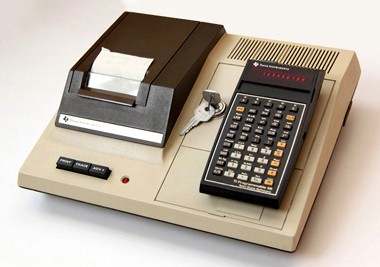 |

 |
The TI-59 |
|
Released at the same time as the TI-58, the TI-59 has many additional advantages
things in common with her sister.
It also has a connector to plug into a thermal printer and
of a dwelling to introduce a memory module containing programs constituting
a thematic library (Maths, Navigation, Statistics ...) but in addition it has a card reader
Magnets for recording programs and data.
In addition, it has a maximum of 960 program steps and can have up to 100 registers.
of data according to the chosen step / register distribution.
A real gem at the time!
The only drawback is that the price of around 2000 French francs corresponds to 2 months of basic salary.
(Cost to which must be added the price of the printer and any modules)
| Year |
Dimensions |
Display |
Registers |
Steps |
| 1977 |
162x81x37mm |
LED 10 (8+2) |
0-100 |
960-160 |
|
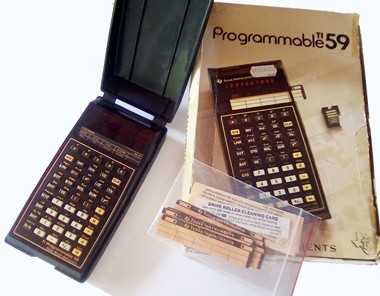 |

 |
The TI-58C |
|
New version of the TI-58, the TI-58C has a constant memory (the C of TI-58C).
The major drawback of the TI-58 has been eliminated!
(See page The TI-58C)
| Year |
Dimensions |
Display |
Registers |
Steps |
| 1978 |
162x81x37mm |
LED 10 (8+2) |
0-60 |
480-0 |
|
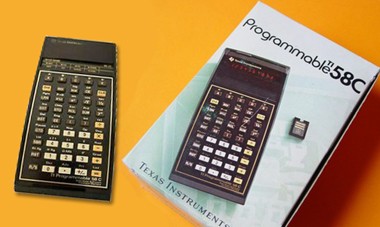 |

 |
The TI-88 |
|
Announced as the successor of the TI-58C / TI-59, the TI-88 was to be released at the end of 1982.
Everything was ready ... Various pre-versions released for testing,
printed manuals and business brochures ready with announcements made on
salons ... Then abandonment ... For no reason?
Many will be advanced : either excessive cost, either internal Texas Instruments problems,
or competition from HP, Sharp... machines.
Who will one day know ?
| Year |
Dimensions |
Display |
Registers |
Steps |
| 1982 |
157x85x41mm |
LCD 10 (8+2) |
0-120 |
960-0 |
|
 |

 |
The TI-66 |
|
Texas Instruments introduced the TI-66 Programmable in 1983 as a successor to the legendary TI-58 and TI-59 calculators.
In fact, the TI-66 is absolutely not comparable to the TI-59 but is closer to the TI-58C, the last model of the 58/59 family.
It has a constant memory of 512 program steps and a maximum of 64 data registers depending on the partitioning chosen.
The TI-66 Programmable was the first horizontal (landscape orientation) Texas Instruments calculator and later has inspired the Galaxy range of calculators.
This programmable TI-66 was manufactured by Toshiba in Japan.
A PC-200 printer can be connected but there are no preprogrammed modules like the TI-58/58C/59.
| Year |
Dimensions |
Display |
Registers |
Steps |
| 1983 |
86x145x15mm |
LCD 10 (8+2) |
0-64 |
512-0 |
|
 |

 |
The TI-95 |
|
The TI-95 Procalc introduced in 1986 is a powerful and impressive programmable calculator.
It has 7200 program steps and 900 data registers depending on the partitioning chosen.
It can receive an additional RAM (8k) or ROM memory module.
The available ROM modules (Mathematics, Statistics, Chemical Engineering) are reminiscent of the TI-58/59 modules ...
A PC-324 printer can be connected as well as an interface allowing the connection of a cassette tape recorder.
The TI-95 Procalc is a real gem ... unfortunately arrived a bit late!
6 years after the Sharp PC1211 (Tandy TRS-80 PC),
5 years after the Casio FX-702P,
but especially well after the HP41C (1979), HP41CV (1980), HP41CX (1984)!
And graphing calculators are coming ...
| Year |
Dimensions |
Display |
Registers |
Steps |
| 1986 |
96x204x25mm |
LCD 16 (10+2) |
0-900 |
7200-0 |
|
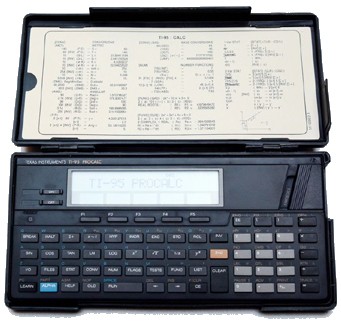 |

|

 |
The SR-56 |
|
The SR-56, a programmable scientific calculator, came out after the SR-52 and cost much less.
And for good reason...
It did not include a magnetic card reader and its memory was much smaller: a program memory of 100 steps with 10 data registers.
This calculator was the precursore of the TI-57 lineage...
| Year |
Dimensions |
Display |
Registers |
Steps |
| 1976 |
147x81x32mm |
LED 10+2 |
10 |
100 |
|
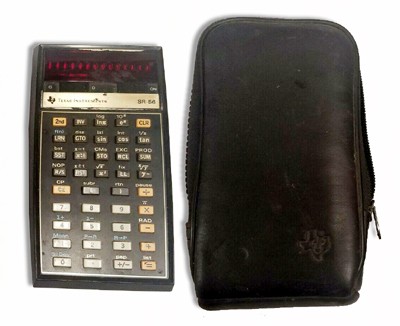 |

 |
The TI-57 |
|
Released at the same time as the TI-58 and TI-59, the TI-57 was the low-budget programmable calculator of that era and replaced the SR-56.
A difference with its big sisters, TI-58 and TI-59, is the "compression" of code in the program steps: [STO] [1] takes a single program step compared to 2 for a TI-58/59.
The calculator is commercially "sold" as a result: its 50 program memory steps would be equivalent to 150 steps on another calculator ... (the ratio of 3 being very exaggerated!)
Certainly [INV] [2nd] [PRD] [2] costs only one step, but an example case does not make the general rule.
Like the TI-58, the TI-57 does not have a magnetic card reader and does not have constant memory, but with only 50 program steps and only 8 data registers the inconvenience is less.
The TI-57 remains a good little programmable that has delighted many users.
The TI-57 was also sold under the brand Radio Shack (EC-4000) and, in Hungary, under the brand Híradástechnika (PTK-1050).
| Year |
Dimensions |
Display |
Registers |
Steps |
| 1977 |
148x78x36mm |
LED 8+2 |
8 |
50 |
|
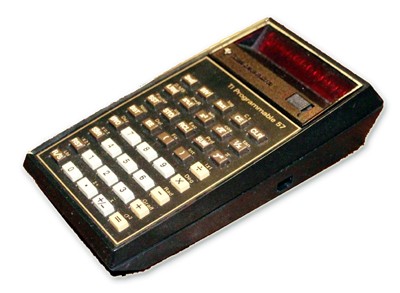 |

 |
The TI-57 LCD |
|
The TI-57 LCD is one of the line of slanted calculators introduced with the TI-55 II in 1981.
A nice presentation, thinner than the TI-57, with an LCD screen with a small line of indicators (2nd, INV, Rad...), a keyboard with 45 keys (instead of 40) and constant memory.
But...
a drastic reduction in overall memory (steps + registers),
performance largely below the TI-57.
What a pity !
The bride was too beautiful...
| Year |
Dimensions |
Display |
Registers |
Steps |
| 1982 |
147x79x23mm |
LCD 8+2 |
1-8 |
48-0 |
|
 |

 |
The TI-57 II |
|
The keyboard of the first generation of "slanted" calculators was a disaster.
After some time of use, the keys malfunctioned or bounced.
Texas Instruments has decided to review the keyboard technology of the previous machines (TI-55 II, TI-57 LCD, BA-55, ...) by adopting a new more reliable technology with new machines (TI-55 III, TI-57 II, BA-54, ....).
So apart from the operation of the keyboard, there is no major difference between the TI-57 LCD and its replacement, the TI-57 II.
| Year |
Dimensions |
Display |
Registers |
Steps |
| 1985 |
147x72x22mm |
LCD 8+2 |
1-7 |
48-0 |
|
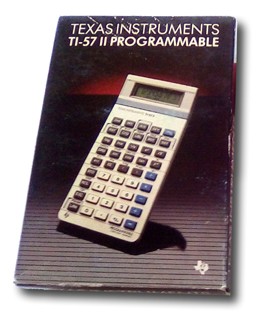 |

 |
The TI-62 Galaxy |
|
The TI-62 is actually a much improved version of the TI-57 LCD and TI-57 II correcting the shortcomings of these models.
To start with: more memory, programs can have up to 100 steps, if all but one of the data registers are converted to program usage.
Conversely, a 42-step program can coexist with 10 data registers.
Then there is a larger display which is used to show the program steps in alphabetical mnemonic form, it displays 10 digit numbers with a two digit exponent.
The keyboard is also a big improvement: the TI-57 LCD had that horribly stiff, bouncy keyboard that Texas Instruments used in many of their early LCD calculators. (This was fixed with the release of the TI-57 II, but the TI-62's "Galaxy" style keyboard is even better.)
The TI-62 is a very interesting and beautiful machine.
| Year |
Dimensions |
Display |
Registers |
Steps |
| 1986 |
89x145x20mm |
LCD 10+2 |
1-10 |
100-42 |
|
 |

 |
The TI-55 |
|
The TI-55, released the same year as the MBA and the TI-57, has the same physique as them (although the MBA is denoted by its colors and graphics) but the TI-55 stands out more for its statistical functions than for its programmatic qualities.
Its programmability is comparable to that of the MBA since, in addition to a program size limited to 32 steps, it is not possible to use branching instructions other than the classic RST as on the MBA.
Note the presence of a factorial function and conversion functions of Imperial units / metric units.
| Year |
Dimensions |
Display |
Registers |
Steps |
| 1977 |
148 x 78 x 36 mm |
LED 8+2 |
10 |
32 |
|
 |

 |
The TI-51 III |
|
The TI-51 III is the European version of the TI-55.
She was marketed in France under the name of powerful scientific and complete statistician.
| Year |
Dimensions |
Display |
Registers |
Steps |
| 1977 |
148 x 78 x 36 mm |
LED 8+2 |
10 |
32 |
|
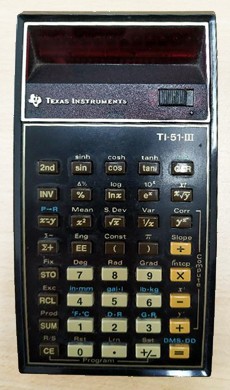 |

 |
The TI-53 (Slimline) |
|
We should have been wary of this TI-53.
In the generation of "Slimline" calculators, the TI-53 was the only one presented as programmable.
With a single data memory and 32 program steps and the impossibility use branching instructions other than the classic RST, the TI-53 is possibly the worst "supposedly programmable" that Texas Instruments has produced.
What makes its charm : to be as "Slimline" inside (in all its possibilities!) as outside!
| Year |
Dimensions |
Display |
Registers |
Steps |
| 1978 |
134 x 74 x 9 mm |
LCD 8 (5+2) |
1 |
32 |
|
 |

 |
The TI-55 II |
|
With the TI-55 II, Texas Instruments starts the generation of "Slanted" calculators.
This calculator offered a larger screen than the previous generation "Slimline" calculators with an LCD display of 8 digits + 2 instead of 5 + 2.
Although its partitioning allows for up to 56 program steps, the TI-55 II actually has less memory than the TI-55.
But its worst flaw will be its keyboard... (same problem as the first generation "Slanted" calculators: TI-57 LCD, BA-55 ...)
| Year |
Dimensions |
Display |
Registers |
Steps |
| 1981 |
147 x 79 x 23 mm |
LCD 8+2 |
1-8 |
56-0 |
|
 |

 |
The TI-53 (Slanted) |
|
It seemed that Texas Instruments had done the worst with the TI-53 "slimline" (slimline).
But with this new TI-53 version "Slanted" (tilted) Texas Instruments broke the record:
the word "PROGRAMMABLE" has been added (in all capitals!).
| Year |
Dimensions |
Display |
Registers |
Steps |
| 1986 |
147 x 72 x 22 mm |
LCD 8 (5+2) |
1 |
32 |
|
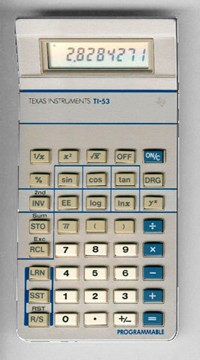 |

 |
The TI-55 III |
|
The TI-55 III is also a replacement calculator like the BA-54, TI-55 II...
Due to the disaster of the keyboards of the first "Slanted" calculators, the TI-55 II had to be replaced.
The only difference, besides the keyboard, between the TI-55 II and the TI-55 III is aesthetic: the TI-55 III it is much more sober and to some it seems less attractive.
Otherwise from the point of view of functionality, they are the same calculators.
| Year |
Dimensions |
Display |
Registers |
Steps |
| 1986 |
147 x 72 x 22 mm |
LCD 8+2 |
1-8 |
56-0 |
|
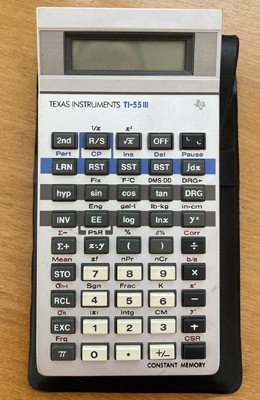 |

 |
The TI-56 |
|
The TI-56 is just the European version of the TI-55 III!
Nothing more, nothing less...
| Year |
Dimensions |
Display |
Registers |
Steps |
| 1986 |
147 x 72 x 22 mm |
LCD 8+2 |
1-8 |
56-0 |
|
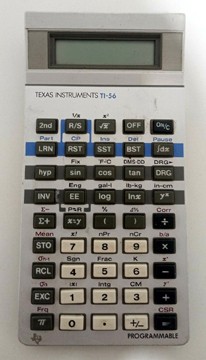 |

 |
The MBA |
|
The calculator called "The MBA" (in the United States) is equipped with advanced financial and statistical functions and initiates the range of "Business Analyst" calculators.
Programmability is extremely light because, in addition to a program size limited to 32 steps, it is not possible to use other branching instructions than the classic RST.
The look of this calculator "The MBA" remains one of the most recognizable with surprising colors and the title of the calculator written in Gothic Italic.
Visually, it is not possible to confuse it with a TI-55 or a TI-57...
| Year |
Dimensions |
Display |
Registers |
Steps |
| 1977 |
148 x 78 x 36 mm |
LED 10 (8+2) |
8-12 |
32-0 |
|
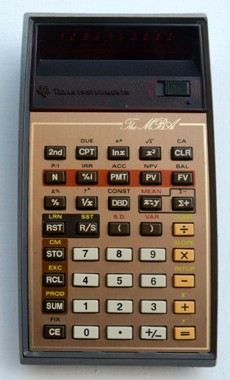 |

 |
The TI-42 MBA |
|
The TI-42 MBA is quite simply the European version of the "The MBA" calculator released a year earlier in the United States.
Why this name for Europeans ???
| Year |
Dimensions |
Display |
Registers |
Steps |
| 1978 |
148 x 78 x 36 mm |
LED 10 (8+2) |
8-12 |
32-0 |
|
 |

 |
The BA-55 |
|
The BA-55 is a "Business Analyst" calculator with very limited programming capability without any branching instructions and only 40 maximum program steps.
Trigonometric functions have disappeared to make way for financial functions.
The BA-55 has a printer connector identical to the TI-66 for connecting a PC-200 Printer for which the Adv, List, Print and Trace instructions are present.
It is surprising to find such functionality on a calculator with such poor programmability.
| Year |
Dimensions |
Display |
Registers |
Steps |
| 1983 |
147 x 79 x 23 mm |
LCD 8 (5+2) |
0-5 |
40-0 |
|
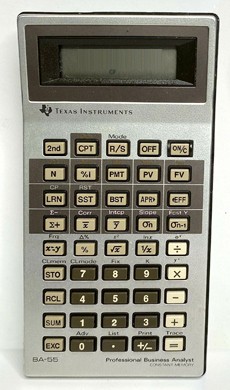 |

 |
The BA-54 |
|
The BA-54 is a replacement calculator. As were also the TI-55 III, TI-57 II...
Indeed, the keyboards of the first "Slanted" calculators were a disaster.
The technology of the keyboards of these previous machines (TI-55 II, TI-57 LCD, BA-55, ...) was therefore reviewed by Texas Instruments which released the new machines (TI-55 III, TI-57 II , BA-54, ....).
In passing, the BA-54 lost the BA-55 printer connector (and the Adv, List, Print and Trace instructions).
| Year |
Dimensions |
Display |
Registers |
Steps |
| 1986 |
147 x 72 x 22 mm |
LCD 8 (5+2) |
0-5 |
40-0 |
|
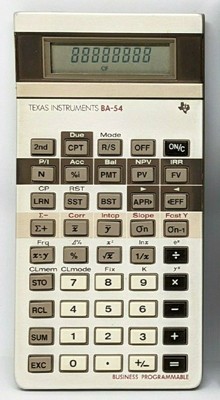 |

 |
The TI-65 |
|
The first impression facing the TI-65 is weird ... the colors, the shape, the 2nd key brown and the 3rd blue ...
No Enter key, so it is indeed an TI !
A surprisingly interesting calculator, this TI-65.
Its shape is reminiscent of other calculators in the "Galaxy" series, such as the TI-62.
Approximately the same number of steps and number of registers ...
The same compact programming with key sequences counting for a single program memory step: therefore a fairly satisfactory program memory size (100 program steps).
The calculator has many programming features:
conditional branching,
the labels,
the sub-programs,
a DSZ loop statement,
...
But the most surprising feature on a TI programmable calculator is the stopwatch per second which is managed using the TUp or TDn instructions.
Is the TI-65 the successor to the TI-62?
Or does it presage the lineage of the TI-68, TI-60, TI-60X ...?
In any case, it raises many questions !
| Year |
Dimensions |
Display |
Registers |
Steps |
| 1987 |
89x145x20mm |
LCD 10+2 |
1-16 |
100-0 |
|
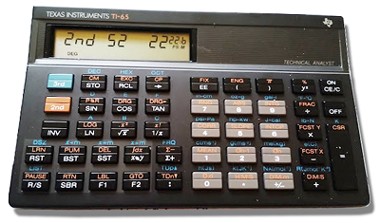 |

 |
The TI-68 |
|
The TI-68 is one of the programmable ones since it is possible to enter a sequence of instructions and then execute it.
It is even possible to enter several programs (up to 26!).
But it would be better to speak of "formulas" rather than programs.
Indeed, there are no branching instructions and calling another program (formula?) is impossible.
Although it has 55 data registers and 440 program steps, the TI-68 only allows you to enter formulas with a maximum of 79 steps each...
No branching, no loop, no condition, no possibility of calling a second program from a first and a severe limitation to 79 steps make this calculator a "not really" programmable.
Despite everything, with its EOS system (Equation Operating System), its multiple functions and its general philosophy, this TI-68 promises to be the precursor of the future TI-67 much more interesting.
| Year |
Dimensions |
Display |
Registers |
Steps |
| 1989 |
150 x 74 x 15 mm |
LCD 12 (8+2) |
0-55 |
440-0 |
|
 |

 |
The TI-60 |
|
The TI-60 is a black calculator in the aesthetic line of "slanted".
Despite many unusual functions (conversions of imperial units (gal, lb, in) into metric units (l, kg, cm), use of hexadecimal and octal ...) and many other more conventional for a "scientist" (statistics, integration, ...) this TI-60 is a little weak for the programming aspect: a maximum of 84 program steps and no connection instructions.
Partitioning is done by mentioning the number of registers desired in hexadecimal (from 1 to C):
2nd
Part
1
for 1 data register and 84 program steps,
2nd
Part
C
for 12 data registers and 7 program steps.
Another "almost" programmable ...
| Year |
Dimensions |
Display |
Registers |
Steps |
| 1990 |
147 x 72 x 22 mm |
LCD 10 (7+2) |
1-12 |
84-7 |
|
 |

 |
The TI-60X |
|
Its name, TI-60X, might make it seem like an improved TI-60. It is not so !
In reality the TI-60X is a TI-68 with less memory and a coarser LCD display: each character is on a 5x4 dot matrix instead of 7x5 dots for the TI-68, which results in less fine characters but more readable.
Because of these criteria the TI-60X is nicknamed the "TI-68 light".
Like the TI-68, the TI-60X does not really record programs but rather formulas (12 max).
Strangely, the alphabet is therefore limited to 12 characters (A, B, C, D, E, F, G, H, I, X, Y and Z) allowing formulas to be named.
| Year |
Dimensions |
Display |
Registers |
Steps |
| 1991 |
150 x 74 x 15 mm |
LCD 12 |
1-12 |
96-8 |
|
 |

 |
The TI-67 |
|
The TI-67 is a full plastic black and gray "Galaxy" with rubber keys.
It closes by sliding into a lid like a drawer.
The programs, whose size is calculated in bytes, are written on one line, the instructions being separated by the character ":" (colon).
The language based on the EOS system (Equation Operating System) is a mixture of SML (Specialized Machine Language) and a pseudo "TI Basic" and can include alphanumeric labels (lbl), conditional (if) and unconditional (goto) branches.
The TI-67 has 90 memories and 1536 bytes available for programs.
The many functions: mathematics, statistics, formulas, sequences ... and the programming methods make it a real programmable scientific calculator.
It only lacks the possibility of being able to connect a printer and to be able to record the programs on an external medium.
| Year |
Dimensions |
Display |
Registers |
Bytes |
| 1992 |
87 x 140 x 17 mm |
LCD 10 (8+2) |
0-90 |
1536-0 |
|
 |

|
Graphing calculators... |
From 1990, graphing calculators will take power ...
 |
 |
 |
 |
 |
 |
 |
 |
|
| TI-81 |
TI-85 |
TI-82 |
TI-80 |
TI-83 |
TI-86 |
TI-73 |
TI-89 |
... |
| (1990) |
(1992) |
(1993) |
(1995) |
(1996) |
(1997) |
(1998) |
(1998) |
|
|

|
 |
Summary |
|
Year |
Dimensions |
Line |
Battery |
Display |
Precision |
Registers |
Steps |
| BA-54 | 1986 | 147 x 72 x 22 mm | Slanted | 2xLR44 | LCD 8 (5+2) | 11 | 0-5 | 40-0 |
| BA-55 | 1983 | 147 x 79 x 23 mm | Slanted | 2xLR44 | LCD 8 (5+2) | 11 | 0-5 | 40-0 |
| SR-52 | 1975 | 164 x 84 x 44 mm | Classic Gen2 | BP1A | LED 10+2 | 12/13 | 20 | 224 |
| SR-56 | 1976 | 147 x 81 x 32 mm | Classic Gen2 | BP1A | LED 10+2 | 12 | 10 | 100 |
| The MBA | 1977 | 148 x 78 x 36 mm | Majestic | BP7 | LED 10 (8+2) | 11 | 8-12 | 32-0 |
| TI-42 MBA | 1978 | 148 x 78 x 36 mm | Majestic | BP7 | LED 10 (8+2) | 11 | 8-12 | 32-0 |
| TI-51 III | 1977 | 148 x 78 x 36 mm | Majestic | BP7 | LED 8+2 | 11 | 10 | 32 |
| TI-53 | 1978 | 134 x 74 x 9 mm | Slimline | 2xLR44 | LCD 8 (5+2) | 11 | 1 | 32 |
| TI-53 | 1986 | 147 x 72 x 22 mm | Slanted | 2xLR44 | LCD 8 (5+2) | 11 | 1 | 32 |
| TI-55 | 1977 | 148 x 78 x 36 mm | Majestic | BP7 | LED 8+2 | 11 | 10 | 32 |
| TI-55 II | 1981 | 147 x 79 x 23 mm | Slanted | 2xLR44 | LCD 8+2 | 11 | 1-8 | 56-0 |
| TI-55 III | 1986 | 147 x 72 x 22 mm | Slanted | 2xLR44 | LCD 8+2 | 11 | 1-8 | 56-0 |
| TI-56 | 1986 | 147 x 72 x 22 mm | Slanted | 2xLR44 | LCD 8+2 | 11 | 1-8 | 56-0 |
| TI-57 | 1977 | 148 x 78 x 36 mm | Majestic | BP7 | LED 8+2 | 11 | 8 | 50 |
| TI-57 II | 1985 | 147 x 72 x 22 mm | Slanted | 2xLR44 | LCD 8+2 | 11 | 1-7 | 48-0 |
| TI-57 LCD | 1982 | 147 x 79 x 23 mm | Slanted | 2xLR44 | LCD 8+2 | 11 | 1-8 | 48-0 |
| TI-58C | 1978 | 162 x 81 x 37 mm | TI58/59 Serie | BP1A | LED 10 (8+2) | 13 | 0-60 | 480-0 |
| TI-58 | 1977 | 162 x 81 x 37 mm | TI58/59 Serie | BP1A | LED 10 (8+2) | 13 | 0-60 | 480-0 |
| TI-59 | 1977 | 162 x 81 x 37 mm | TI58/59 Serie | BP1A | LED 10 (8+2) | 13 | 0-100 | 960-160 |
| TI-60 | 1990 | 147 x 72 x 22 mm | Slanted | 2xLR44 | LCD 10 (7+2) | 13 | 1-12 | 84-7 |
| TI-60X | 1991 | 150 x 74 x 15 mm | 60 | CR2032 | LCD 12 | 13 | 1-12 | 96-8 |
| TI-62 | 1986 | 89 x 145 x 20 mm | Galaxy | 2xLR44 | LCD 10+2 | 13 | 1-10 | 100-42 |
| TI-65 | 1987 | 89 x 145 x 20 mm | Galaxy | 2xLR44 | LCD 10+2 | 13 | 1-16 | 100-0 |
| TI-66 | 1983 | 86 x 145 x 15 mm | Galaxy | 2xLR44 | LCD 10 (8+2) | 13 | 0-64 | 512-0 |
| TI-67 | 1992 | 87 x 140 x 17 mm | Galaxy | 2xLR44 | LCD 10 (8+2) | 13 | 0-90 | 1536-0 |
| TI-68 | 1989 | 150 x 74 x 15 mm | 60 | CR2032 | LCD 12 (8+2) | 13 | 0-55 | 440-0 |
| TI-88 | 1982 | 157 x 85 x 41 mm | | BP88 | LCD 10 (8+2) | 13 | 0-120 | 960-0 |
| TI-95 | 1986 | 96 x 204 x 25 mm | Procalc | 4xLR3 | LCD 16 (10+2) | 13 | 0-900 | 7200-0 |

|








